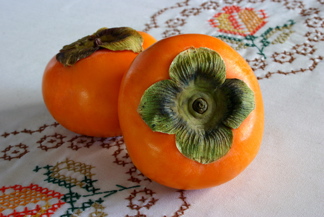Persimmons
 |
These beautiful autumn fruits are most flavorful when allowed to
soften. Smooth and creamy enough to spoon out like a pudding,
persimmons can be eaten fresh or mixed into baked goods, sauces and desserts.
|
This orange-colored autumn fruit has a smooth skin and jelly-like
flesh that ranges from quite tart to delicately sweet when ripe. It's a
favorite for eating fresh out of hand, especially with a spoon.
Persimmons are also often candied, added to fruit salads or mixed into
baked goods, puddings and desserts.
History
The persimmon is nicknamed "the apple of the orient." Although it originated in China, it's the national fruit of Japan, where it's been cultivated for 1,000 years.Varieties
Persimmons can be separated into two separate types: astringent (pungent or tart) and nonastringent (mild or sweet). There are over 400 species grown worldwide, but the most popular include:Hachiya—Also called Japanese persimmon and kaki, this is the most widely available persimmon in the U.S. It's large (up to 3 inches in diameter) and round in shape with a slightly pointed base. This mouth-puckering astringent variety has a smooth and creamy burnt orange flesh containing a few black edible seeds. It's best when soft and mushy and great for eating with a spoon or mixing into puddings, cakes, breads and sauces.
Fuyu—Smaller and slightly flattened in shape, this nonastringent variety is sweeter and firmer when ripe. With an edible skin and crisp, seedless flesh, it can be eaten like an apple, added to fruit salads or poached like a pear.
Sharon—Also nonastringent, this sweet, round Israeli persimmon is found in Europe and the Middle East. With a pear-like sweetness, it can be enjoyed when slightly underripe and firm. When softened, it can still be eaten out of hand or used for cooking.
Buying Tips
Persimmons are available from October through February. When buying, choose fruits that are brightly colored with smooth, shiny skins and green caps. They should be plump and soft, but not mushy; the Fuyu variety should be firm to the touch.Storage Tips
Refrigerate ripe persimmons in a plastic bag for up to three days. Fruits that are not quite ripe may be stored at room temperature or placed in a pierced paper bag with an apple. Overripe persimmons turn quite mushy, so watch them carefully.Usage Tips
• For eating out hand, simply wash well and enjoy. For cooking, peel the skin first.• Remove the black seeds in Hachiyas before adding the flesh to recipes.
• When using for cooking or baking, purée each persimmon with one teaspoon of lemon juice to keep the fruit from darkening.
• For a refreshing treat, cut persimmons I





